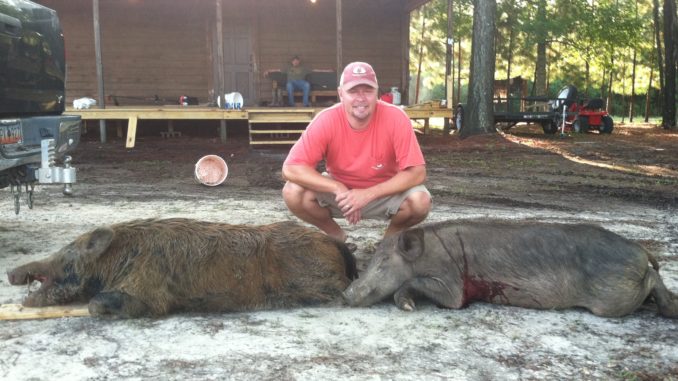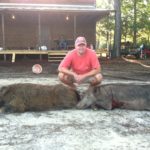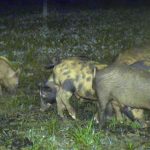
Expanding population of wild hogs gives South Carolina hunters a leg up on year-round sport.
Hog hunting is a very popular sport in South Carolina and one that hunters can enjoy throughout the year, around the clock within certain parameters.
But there are hunters who hunt hogs — and then there are hog hunters.
Robbie Cortis, 39, of Mount Pleasant resident is the latter.
“I truly have a passion for hunting hogs, and it’s much more than just a simple way to pass the time,” Cortis said. “I hunt hogs for a variety of reasons, but foremost, it’s that they are an excellent game animal, in my opinion.
“In some areas, there are huge populations, and you see a lot of hogs. They require skill to hunt successfully because their sense of smell is outstanding, and they do certainly have the ability to learn. I learned that by shooting a couple in a spot and discovered the other pigs figure out real quick something’s going on.
“I also love to eat wild hogs, and I think — properly prepared — they are great eating. Plus, they are great fun for youngsters, and I love to take my kids hogs hunting. And hunting them anytime I want to, even at night with certain restrictions, is also appealing. Plus, I also have hunted them with dogs, and that is fun and productive, but I personally prefer the one-on-one style of hunting”
Cortis said to him there’s just no downside to hunting hogs.
“I take hunting hogs or pigs seriously and usually put as much effort into a good game plan as I do deer,” he said. “However, with hogs there are different issues to consider so some of my best areas are primarily hog hunting areas.”
Cortis said there are two primary ways he enjoys hog hunting. One is to simply use natural sign and their natural preferences for certain foods and water and hunt them without luring them with bait. He said the other is with the use of bait.
“I use a variety of weapons on hogs, and that includes a .270 rifle, archery equipment as well as a pistol,” he said. “When hunting with a firearm, I generally shoot hogs in the head for a quick, clean kill. Each type of hunting is unique and demands different skill sets, but hunters can be successful with each.
“In February, hogs are hungry, so it’s an ideal time,” Cortis said. “Not a lot of natural forage is found at this time, and when you locate a place they’re using, there’s a really good chance you’ll have the opportunity to take hogs. It’s imperative to approach it right in terms of not leaving too much human scent and playing the wind properly when you set up. But you still have to find them to kill them, and I enjoy the scouting part of the hunting process because I’ll also find deer and turkey sign that I mentally store for hunting those animals during those hunting seasons.
“One common denominator I’ve found when hunting hogs, and that’s water, particularly swamps and low areas where they have access to significant drainages,” Cortis said. “Hogs can be killed in upland areas, but often, that’s where bait or natural food is more important to help draw them to a specific site. If hunting hogs without bait, I generally focus my hunts around water.
“I use water as a general area to hunt, but I spend time looking for sign to be in the exact right place and finding where they are feeding at that time first,” Cortis said. “I’ve found areas with a lot of rooting, but even if it’s a few days old, the hogs may have left for literally greener pastures. I look for very fresh sign around swamps and waters where I hunt.
“Usually, it’s easy to spot, and often when scouting, I’ll be hunting and have my rifle. I’ll work against the wind since smell is their great defense, and actually seeing pigs is the best sign. If I’m in good position, I’ll take one by actually stalking them and that’s a much more productive technique than many think and it’s great fun and a real challenge.
“If the situation isn’t right for a good shot, I’ll check the area and time of day and watch the direction the hogs move from and toward,” he said. “Then I’ll be back soon to hunt that specific area. This is where a climbing stand can be of great assistance to get in a hot area quickly. I have to consider the wind direction and have a good idea from the direction they’ll approach. If there’s water nearby, they’ll likely approach from that direction.”
“When you start scouting before your hunt, realize that pigs need water, so that’s often a key element to success in terms of where to begin your scouting efforts,” Cortis said. “Pigs need water to cool down, and that is why they are often active at night when it is cooler and a reason they wallow in the mud around water sources. This is a major weakness that a hunter can take advantage of by simply looking for those signs of use along with and rooting and feeding.”
Cortis said he has found natural spots where pigs like to frequent and he has permanent stands that take advantage of the prevailing winds. Often, he doesn’t have to use bait, but since baiting is legal, he will at times use that as a tool to draw and keep hogs in the area.
“Usually, I won’t spend much time in these areas except to bait to ensure a minimum of human scent is left, but I will use corn, sometimes soured corn, to attract the hogs,” he said. “This opens up another great hunting possibility and that’s with hunting with kids. I love to take my kids hog hunting and have found it’s a great way to introduce them to the sport of hunting large game.
“Hogs have a great sense of smell, but they don’t see or hear as well as deer, so that helps with kids. But get the wind in your face — especially if you have an area baited near fresh sign — and typically, it’s not long before hogs arrive. Some of my best hog-hunt memories have been with kids, watching them learn the basics of hunting big-game animals. Typically, that helps develop their desire to hunt other species and become outdoors-oriented. That’s a great place for any youngster to be these days: hunting hogs, deer, turkey and small game. But it’s easy and fun to get them started with hogs.”
Cortis said finding hogs is not really difficult when baiting in areas with high populations.
“I’ll begin with a area that’s a good place naturally, near a good water source with fresh sign, and then slip in to spot check. I can tell quickly if the corn is being eaten by hogs,” he said. “When it looks like there’s heavy use, I’ll slip back in, and this is also a great way to take pigs with archery equipment.”
Cortis goes the extra mile in his hog hunting, using trial cameras just as he does for deer.
“Hogs move, and an area that’s hot for a while cools off, but with as many hogs as we have around our major river drainages, they’ll be active somewhere,” he said. “So I use trail cameras to stay on top of hog movement both in prime natural areas or where there’s bait. A little extra effort like this goes a long way to finding an abundance of hogs. On a good hunt, it‘s not unusual to see several hogs — maybe a dozen or more at a time. When hunting with kids or a buddy, things can get real interesting and fun with multiple hogs in the open and the wind in your favor.”
Cortis’ passion for hogs doesn’t end with just the hunt, he love to eat them as well.
“My entire family loves wild hogs; we eat them all the time,” he said. “Part of that is because we love to hunt them, we’ve got plenty of meat. But for those who turn their nose up at eating wild hogs, I think they just haven’t found how to properly clean and cook them. I prefer hogs that are about 150 pounds or less, but if handled properly after the shot, even large hogs can be excellent table fare.
“One of my favorite ways is to cook a wild hog is on a smoker or even in a crock pot, and that will really get the meat tender. It’s a matter of using the right spices and rubs to enhance the flavor of the meat. Lots of recipes can be found on the internet to prepare wild hogs.”
Cortis said that while hogs and water go together, some of his most memorable hunts have been in large agriculture fields.
“I love to slip though big fields such as beans, cotton or corn and literally keep the wind in my face and slip up on hogs,” Cortis said. “The largest wild hog I’ve killed weighed 315 pounds and was taken this way — stalking though a cotton field. A 300-pounds-plus wild hog, never kept in a pen, is really a big, wild hog. This requires patience, woodsmanship and often being able to make an accurate and quick shot. It requires a lot of a hunter, and I assure you it will challenge and enhance your hunting skills.”
Cortis said that the number of hogs in South Carolina does seem to be on the increase, and keeping numbers in check on the land he hunts for deer and turkey is another benefit of hunting hogs year round.
“Hog hunting is just a great sport in and of itself,” Cortis said, “but the side benefits of property protection and management of other species are other factors. Hunting at night is fun, but ensure you read and follow the specific guidelines for hunting hogs after dark.”
Charles Ruth, a wildlife biologist with the S.C. Department of Natural Resources agrees that there are plenty of advantages to hunting hogs.
“Wild or feral hogs are often thought of as game animals, and there is a certain amount of sport associated with harvesting hogs,” Ruth said. “Wild hogs provide quality meat for the hunter, and mature hogs can make a highly sought-after trophy.”
According to the Ruth, recent relocation of wild hogs by people appear to be responsible for the species populating areas where they were not found in the past.
“Wild hogs directly compete with native species like deer and wild turkey for habitat and food, and hogs can do significant damage to the habitat and agricultural production through their rooting activities,” Ruth said. “Legislation passed during the 2005 session of the South Carolina General Assembly prohibits the release of hogs in the state, and legislation passed in 2010 prohibits the removal of a live hog from the woods without a permit.”
Cortis said February is a great time to hog hunt, but with no limits on hogs taken, year-round and day and night legal hunting, hunters can adapt methods for year round success and enjoy the resource and help control the population.






Be the first to comment